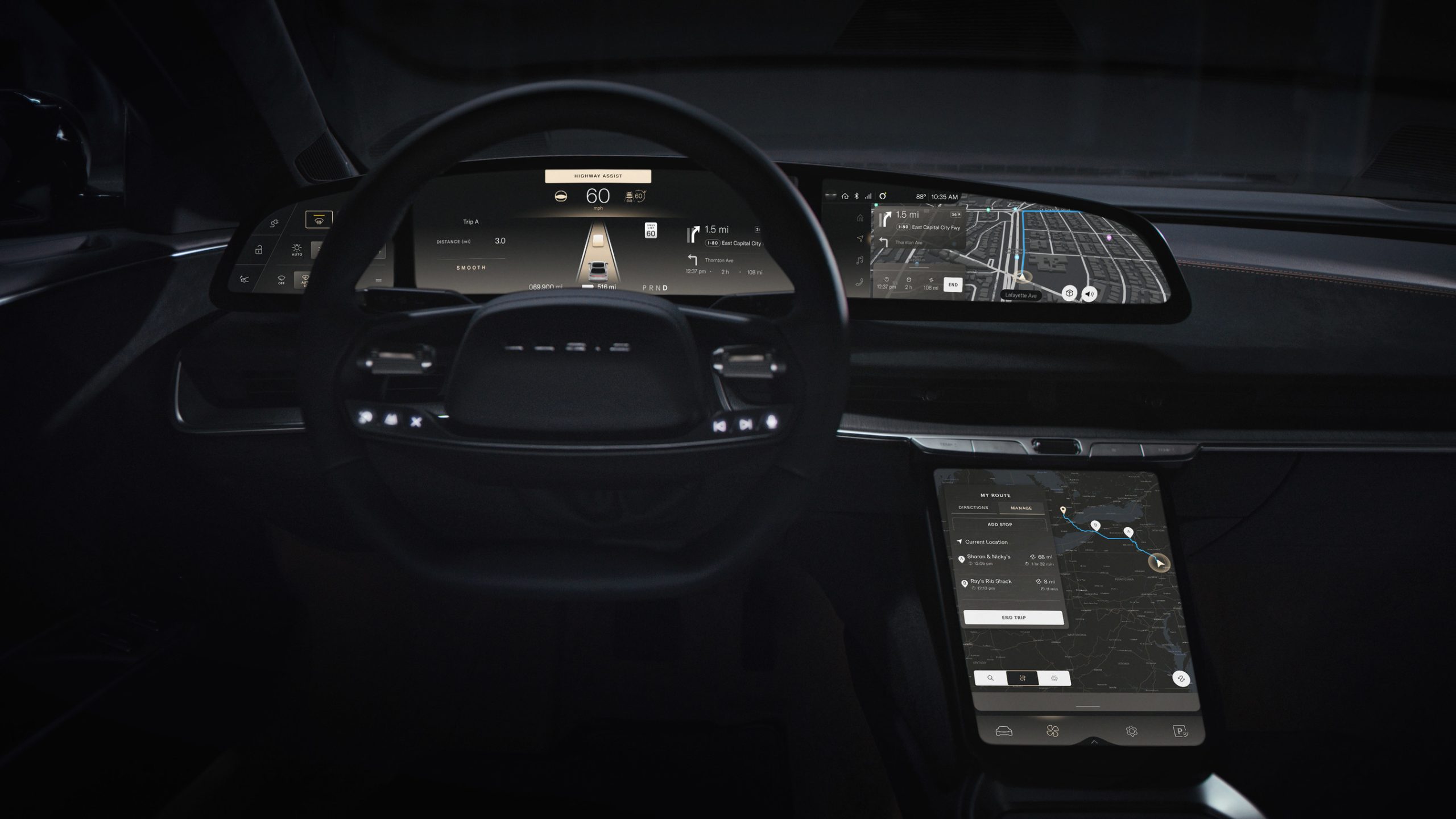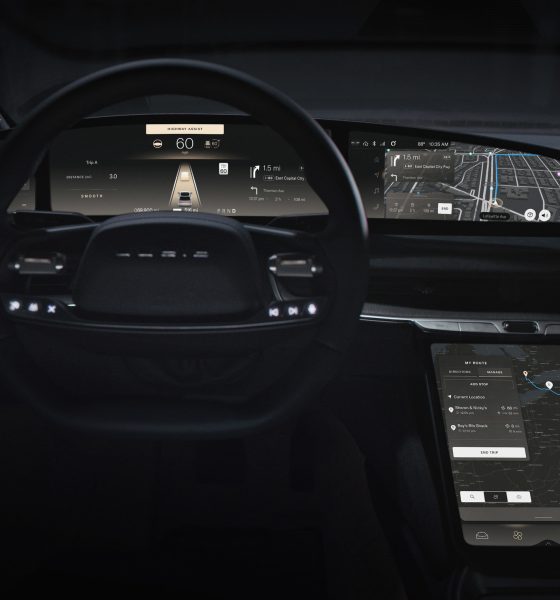

News
Lucid launches its biggest OTA update yet with ‘hundreds’ of new features
Lucid announced this morning it had launched Lucid UX 2.0, its most extensive and biggest software update, which packs “hundreds of updates and new features for every Lucid Air on the road.”
Designed as a “true software-defined vehicle,” Lucid says the Air will benefit vastly from the array of new improvements. Including new features like “Instant-On” Glass Cockpit and Pilot Panel Displays, the launch of “Highway Assist” for DreamDrive, and redesigned on-screen layouts, Lucid said the complementary update makes the vehicle more enjoyable and easier to use.
A defining moment for our software-defined vehicles. Our latest software update, Lucid UX 2.0, is our most significant rollout yet. Learn about our new features and overall improvements. #DreamAheadhttps://t.co/yvLFpBPchz pic.twitter.com/w0Cdbi0MNS
— Lucid Motors (@LucidMotors) October 13, 2022
Since launching deliveries of the Air last year, Lucid has worked to ramp production and solve supply chain issues that have plagued the automaker’s progress. Yesterday, the company announced one of its strongest quarters to date, with 2,282 units produced last quarter with 1,398 delivered.
It has been a bright spot on a relatively disappointing year as Lucid has trimmed delivery projections for 2022 on two occasions. First aiming for 20,000 vehicles produced in 2022, then slashing to between 12,000 and 14,000 vehicles. In August, Lucid pushed this goal back to between 6,000 and 7,000 vehicles.
Software Improvements
Lucid’s early EV software has been hit-and-miss, with some owners detailing various issues with basic functions that have made the vehicles stressful to drive. However, the automaker has developed a vast update that starts at the heart of software. SVP of Digital for Lucid, Michael Bell, detailed the improvements:
“This extensive software update, comprising tens of millions of new lines of source code across nearly every updateable computer in the vehicle, is achievable because the Lucid Air was engineered from the start with the capability to get better over time. Thanks to our integrated software and hardware engineering, Lucid has the in-house technical depth to enhance our vehicles long after they leave the assembly line.”
The Lucid UX 2.0 is completely designed and fabricated on owner feedback and ideas, Derek Jenkins, Senior VP of Design and Brand said. “Lucid’s truly innovative user interface becomes easier to use and even more aesthetically beautiful in each iteration, delivered seamlessly over-the-air to the vehicle.”
Glass Cockpit and Pilot Panel Displays
- “Instant-on” displays, so the car is ready to drive as soon as the driver sits down and buckles up.
- New on-screen layout for the Glass Cockpit display, moving the controls for the most-used apps like Home, Navigation, Media, and Phone to make Lucid UX more ergonomically friendly than ever.
- Updated Navigation and maps, with turn-by-turn directions now appearing on the center display directly ahead of the driver.
- More-intelligent prediction of remaining range, so drivers know even better what they can expect on the road.
- Do more with Alexa Built-In voice control, such as change the climate control settings for the rear seat.
- A more user-friendly browsing experience for third-party media apps, making it easier to see options, select favorite tunes, and start listening more quickly.
DreamDrive and Advanced Driver Assistance Systems
- Highway Assist with active lane centering and adaptive cruise control, allowing for even greater driving comfort on long journeys.
- Rear Pedestrian Collision Protection is now also enabled when the vehicle is in Drive and rolling backwards.
- Improvements to visual cues for Park Distance Warning feature.
Intelligent Micro Lens Array Headlights
- High Beam Assist that detects not only other vehicles, but other sources of nearby light, and automatically switches to low beams when most appropriate.
- Automatic headlight leveling with sensor-based adjustments for height and vehicle angle in relation to the ground.
Vehicle Entry and Exit
- New De-Ice Mode combines defrost, automatic wiper blade movement, and wiper fluid to clear ice that may be obstructing the view through the windshield.
- A number of measures to make automatic locking and unlocking simpler, more intuitive, and more responsive with both the key fob and Mobile Key, as well as additional user-customizable settings.
Disclosure: Joey Klender is not an LCID shareholder.
I’d love to hear from you! If you have any comments, concerns, or questions, please email me at joey@teslarati.com. You can also reach me on Twitter @KlenderJoey, or if you have news tips, you can email us at tips@teslarati.com.

News
Nvidia CEO Jensen Huang explains difference between Tesla FSD and Alpamayo
“Tesla’s FSD stack is completely world-class,” the Nvidia CEO said.

NVIDIA CEO Jensen Huang has offered high praise for Tesla’s Full Self-Driving (FSD) system during a Q&A at CES 2026, calling it “world-class” and “state-of-the-art” in design, training, and performance.
More importantly, he also shared some insights about the key differences between FSD and Nvidia’s recently announced Alpamayo system.
Jensen Huang’s praise for Tesla FSD
Nvidia made headlines at CES following its announcement of Alpamayo, which uses artificial intelligence to accelerate the development of autonomous driving solutions. Due to its focus on AI, many started speculating that Alpamayo would be a direct rival to FSD. This was somewhat addressed by Elon Musk, who predicted that “they will find that it’s easy to get to 99% and then super hard to solve the long tail of the distribution.”
During his Q&A, Nvidia CEO Jensen Huang was asked about the difference between FSD and Alpamayo. His response was extensive:
“Tesla’s FSD stack is completely world-class. They’ve been working on it for quite some time. It’s world-class not only in the number of miles it’s accumulated, but in the way it’s designed, the way they do training, data collection, curation, synthetic data generation, and all of their simulation technologies.
“Of course, the latest generation is end-to-end Full Self-Driving—meaning it’s one large model trained end to end. And so… Elon’s AD system is, in every way, 100% state-of-the-art. I’m really quite impressed by the technology. I have it, and I drive it in our house, and it works incredibly well,” the Nvidia CEO said.
Nvidia’s platform approach vs Tesla’s integration
Huang also stated that Nvidia’s Alpamayo system was built around a fundamentally different philosophy from Tesla’s. Rather than developing self-driving cars itself, Nvidia supplies the full autonomous technology stack for other companies to use.
“Nvidia doesn’t build self-driving cars. We build the full stack so others can,” Huang said, explaining that Nvidia provides separate systems for training, simulation, and in-vehicle computing, all supported by shared software.
He added that customers can adopt as much or as little of the platform as they need, noting that Nvidia works across the industry, including with Tesla on training systems and companies like Waymo, XPeng, and Nuro on vehicle computing.
“So our system is really quite pervasive because we’re a technology platform provider. That’s the primary difference. There’s no question in our mind that, of the billion cars on the road today, in another 10 years’ time, hundreds of millions of them will have great autonomous capability. This is likely one of the largest, fastest-growing technology industries over the next decade.”
He also emphasized Nvidia’s open approach, saying the company open-sources its models and helps partners train their own systems. “We’re not a self-driving car company. We’re enabling the autonomous industry,” Huang said.
Elon Musk
Elon Musk confirms xAI’s purchase of five 380 MW natural gas turbines
The deal, which was confirmed by Musk on X, highlights xAI’s effort to aggressively scale its operations.

xAI, Elon Musk’s artificial intelligence startup, has purchased five additional 380 MW natural gas turbines from South Korea’s Doosan Enerbility to power its growing supercomputer clusters.
The deal, which was confirmed by Musk on X, highlights xAI’s effort to aggressively scale its operations.
xAI’s turbine deal details
News of xAI’s new turbines was shared on social media platform X, with user @SemiAnalysis_ stating that the turbines were produced by South Korea’s Doosan Enerbility. As noted in an Asian Business Daily report, Doosan Enerbility announced last October that it signed a contract to supply two 380 MW gas turbines for a major U.S. tech company. Doosan later noted in December that it secured an order for three more 380 MW gas turbines.
As per the X user, the gas turbines would power an additional 600,000+ GB200 NVL72 equivalent size cluster. This should make xAI’s facilities among the largest in the world. In a reply, Elon Musk confirmed that xAI did purchase the turbines. “True,” Musk wrote in a post on X.
xAI’s ambitions
Recent reports have indicated that xAI closed an upsized $20 billion Series E funding round, exceeding the initial $15 billion target to fuel rapid infrastructure scaling and AI product development. The funding, as per the AI startup, “will accelerate our world-leading infrastructure buildout, enable the rapid development and deployment of transformative AI products.”
The company also teased the rollout of its upcoming frontier AI model. “Looking ahead, Grok 5 is currently in training, and we are focused on launching innovative new consumer and enterprise products that harness the power of Grok, Colossus, and 𝕏 to transform how we live, work, and play,” xAI wrote in a post on its website.
Elon Musk
Elon Musk’s xAI closes upsized $20B Series E funding round
xAI announced the investment round in a post on its official website.

xAI has closed an upsized $20 billion Series E funding round, exceeding the initial $15 billion target to fuel rapid infrastructure scaling and AI product development.
xAI announced the investment round in a post on its official website.
A $20 billion Series E round
As noted by the artificial intelligence startup in its post, the Series E funding round attracted a diverse group of investors, including Valor Equity Partners, Stepstone Group, Fidelity Management & Research Company, Qatar Investment Authority, MGX, and Baron Capital Group, among others.
Strategic partners NVIDIA and Cisco Investments also continued support for building the world’s largest GPU clusters.
As xAI stated, “This financing will accelerate our world-leading infrastructure buildout, enable the rapid development and deployment of transformative AI products reaching billions of users, and fuel groundbreaking research advancing xAI’s core mission: Understanding the Universe.”
xAI’s core mission
Th Series E funding builds on xAI’s previous rounds, powering Grok advancements and massive compute expansions like the Memphis supercluster. The upsized demand reflects growing recognition of xAI’s potential in frontier AI.
xAI also highlighted several of its breakthroughs in 2025, from the buildout of Colossus I and II, which ended with over 1 million H100 GPU equivalents, and the rollout of the Grok 4 Series, Grok Voice, and Grok Imagine, among others. The company also confirmed that work is already underway to train the flagship large language model’s next iteration, Grok 5.
“Looking ahead, Grok 5 is currently in training, and we are focused on launching innovative new consumer and enterprise products that harness the power of Grok, Colossus, and 𝕏 to transform how we live, work, and play,” xAI wrote.








